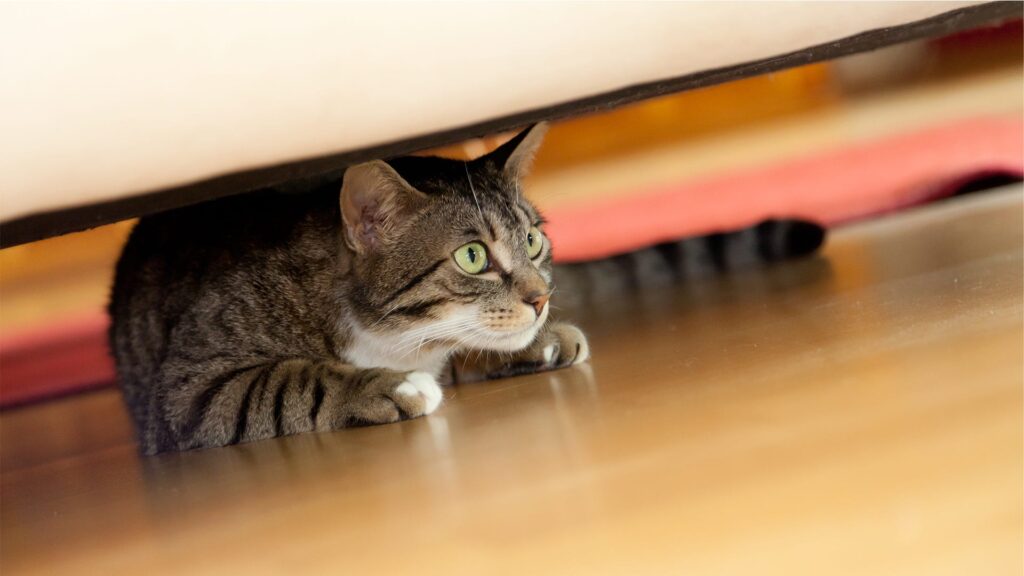Everything You Need To Know About Keeping A Cat in One Room: Cats can be successfully kept in one room as long as certain conditions are met. We will explore the necessary steps to ensure your cat’s comfort and well-being in a limited space, including providing appropriate stimulation, creating a safe environment, and meeting their needs for food, water, and hygiene.
We will also discuss the importance of regular play and exercise, as well as the benefits of interactive toys and scratching posts. By following these guidelines, you can create a happy and contented living space for your feline friend, even if it is limited to a single room.

Credit: www.reddit.com
Contents
- 1 Understanding The Needs Of Cats In A Limited Space
- 2 Creating A Safe And Enriching Space For Your Cat
- 3 Meeting Your Cat’s Basic Needs In A Confined Space
- 4 Keeping Your Cat Mentally Stimulated
- 5 Addressing Behavioral Issues In A Single Room Environment
- 6 Seeking Veterinary Care And Preventive Measures
- 7 Creating A Positive Social Environment For Your Cat
- 8 Monitoring And Managing Your Cat’s Health And Well-being
- 9 Tips For Transitioning To A Larger Living Space
- 10 Frequently Asked Questions Of Everything You Need To Know About Keeping A Cat In One Room
- 11 Conclusion
Understanding The Needs Of Cats In A Limited Space
Keeping a cat in a limited space, such as one room, requires understanding the needs and providing a suitable living environment for your feline friend. Cats are naturally curious and active creatures, so it is important to ensure their physical and mental well-being.
One of the factors to consider is providing enough vertical space for your cat. Cats love to climb and perch, so providing cat trees or shelves can give them the opportunity to explore and exercise. Additionally, providing hiding spots such as boxes or beds can give your cat a sense of security.
Another important consideration is enrichment and stimulation. This can be achieved by providing interactive toys, scratching posts, and puzzle feeders. It’s vital to engage in playtime with your cat daily to keep them mentally and physically stimulated.
Maintaining a consistent routine is crucial for a cat living in a confined space. This includes establishing regular feeding times and providing a litter box in a quiet and accessible location. Regular grooming sessions are also necessary to maintain their hygiene and overall well-being.
In conclusion, keeping a cat in one room can be a fulfilling experience with the right approach. By understanding their needs, providing vertical space, enrichment, and maintaining a consistent routine, you can create a stimulating and comfortable environment for your furry companion.
Creating A Safe And Enriching Space For Your Cat
Providing a safe and enriching space for your cat is essential when you are keeping them in one room. Cats need sufficient room for exercise and play to stay happy and healthy. Incorporating vertical space is a great way to maximize the available room. Install shelves or a cat tree for climbing and jumping. Make sure to secure any breakable items that could be knocked over during playtime. Introduce interactive toys and scratching posts to keep your cat engaged and provide them with mental stimulation.
Setting up a comfortable sleeping area is also important. Cats value a cozy and quiet place to retreat to. Consider providing a soft bed or blanket in a secluded spot where your cat can relax and feel secure. Avoid placing the sleeping area too close to their litter box or food bowls to maintain cleanliness and promote a healthy living space.
Meeting Your Cat’s Basic Needs In A Confined Space
Keeping a cat in one room can be a challenge, but with the right approach, you can ensure their basic needs are met. Nutrition and hydration are essential for a cat’s well-being, even in a confined space. Make sure to provide a balanced diet that meets their specific nutritional requirements. You can consult with a veterinarian to find the right food for your cat. Fresh water should be available at all times, and it’s crucial to regularly clean and refill their water bowl to prevent contamination.
Maintaining good hygiene and cleanliness in the room is important for both you and your cat. Regularly clean the litter box to prevent odor and keep your cat’s space clean. Use cat-friendly cleaning products to ensure their safety. Additionally, it’s crucial to regularly groom your cat to keep their coat healthy and reduce shedding. Engage them in playtime and provide scratching posts to satisfy their natural instincts and keep them active.
Keeping Your Cat Mentally Stimulated
Keeping your cat mentally stimulated is essential when they are confined to one room. Engaging toys and interactive play are great ways to keep your furry friend entertained and mentally engaged. Provide a variety of toys that encourage their natural hunting instincts, such as puzzle feeders or toys that dispense treats.
Incorporating scratching posts and climbing structures will also keep your cat mentally stimulated. Cats love to scratch and climb, so having designated areas for these activities will prevent them from getting bored or restless. Choose scratching posts made of sisal or cardboard and place them strategically around the room.
Consider providing vertical spaces for your cat to explore, such as tall cat trees or shelves mounted on the walls. This will allow them to climb, jump, and survey their surroundings from a higher vantage point.
In addition to toys and climbing structures, don’t forget to give your cat plenty of affection and attention. Play interactive games with them using toys like fishing rod-style toys or laser pointers. Spend time petting and cuddling with them to make sure they feel loved and cherished.
Addressing Behavioral Issues In A Single Room Environment
Addressing Behavioral Issues in a Single Room Environment
Keeping a cat in one room can present certain challenges, especially when it comes to addressing behavioral issues. One common issue is dealing with litter box challenges. It’s important to provide your cat with a clean and accessible litter box. Make sure to scoop it regularly and keep it in a quiet area of the room. Additionally, consider using a litter attractant to encourage your cat to use the box.
Another issue that may arise in a single room environment is managing territorial and aggression issues. Providing vertical spaces, such as tall cat trees or shelves, can help your cat feel more secure and reduce the likelihood of aggressive behavior. Creating multiple hiding spots throughout the room can also give your cat a sense of privacy and help prevent conflicts with other pets or people.
| Addressing Behavioral Issues in a Single Room Environment |
| Dealing with Litter Box Challenges |
| 1. Keep the litter box clean and accessible |
| 2. Scoop regularly and use a litter attractant |
| Managing Territorial and Aggression Issues |
| 1. Provide vertical spaces for cats |
| 2. Create multiple hiding spots |
Seeking Veterinary Care And Preventive Measures
Taking your cat to the veterinarian for regular check-ups is crucial for their overall health and well-being. Regular check-ups allow the vet to assess your cat’s health, detect any potential issues early on, and provide the necessary vaccinations to prevent common diseases. Vaccinations are essential for protecting your cat from various viruses, bacteria, and parasites.
Tips for managing parasite control in a limited space:
| Tip | Description |
|---|---|
| 1 | Keep the living area clean and hygienic to minimize the risk of parasites. |
| 2 | Use flea and tick preventive treatments as recommended by your veterinarian. |
| 3 | Regularly groom your cat to check for any signs of fleas, ticks, or other parasites. |
| 4 | Provide your cat with indoor enrichment to keep them mentally stimulated, reducing the risk of stress-related health issues. |
| 5 | Consider using cat-friendly indoor plants that can naturally repel certain insects and pests. |
By following these tips and seeking veterinary care regularly, you can ensure that your cat stays healthy and happy, even in a limited space.
Creating A Positive Social Environment For Your Cat
Creating a positive social environment for your cat is essential for their overall well-being. One way to provide socialization opportunities for your cat is by allowing them to interact with visitors. Introducing your cat to new people helps them become comfortable with different individuals and reduces stress when visitors come over. It’s important to encourage visitors to interact with your cat in a gentle and calm manner, allowing your cat to approach them at their own pace. This can help build trust and create a positive association with strangers. Additionally, considering the addition of a second cat as a companion can also provide social interaction and companionship for your cat. However, it’s important to introduce new cats slowly and allow them time to adjust to each other’s presence. Providing appropriate space, resources, and supervision during the introduction process can help ensure a successful transition.
Monitoring And Managing Your Cat’s Health And Well-being
Keeping a cat confined to one room can present some challenges, but with proper monitoring and management, you can ensure your cat’s health and well-being. One important aspect is recognizing signs of distress or boredom. Cats may exhibit behaviors such as excessive meowing, scratching furniture, or pouncing on anything that moves. These behaviors could indicate that your cat is not getting enough stimulation. To address this, it’s crucial to implement a routine for exercise and mental stimulation. Play interactive games with your cat using toys or laser pointers to keep them active and engaged. Providing scratching posts, climbing trees, and puzzle toys can also help keep their minds stimulated. Regular veterinary check-ups are essential to monitor your cat’s health and to address any potential issues promptly. Creating a comfortable and safe environment with ample food, water, and a litter box within the room is vital for their well-being.
Tips For Transitioning To A Larger Living Space
Tips for Transitioning to a Larger Living Space
Transitioning your cat to a larger living space can be done smoothly by following a few key strategies. Gradual introduction to new rooms is important. Begin by allowing your cat to explore one room at a time, starting with their main living area. This will help them adjust to the new space and prevent overwhelming them. Provide plenty of hiding spots, such as cat trees or cardboard boxes, in each room to help make the transition easier. It’s essential to minimize stress during this process. Stick to a consistent routine, including feeding times and play sessions.
Additionally, you can use Feliway diffusers or calming sprays to create a soothing environment. Finally, spend quality time with your cat, offering cuddles and attention to make them feel safe and loved in their new surroundings. By following these tips, you can ensure a smooth transition for your beloved feline companion.
Frequently Asked Questions Of Everything You Need To Know About Keeping A Cat In One Room
How Long Can You Keep A Cat In One Room?
You should not keep a cat in one room for more than a few hours a day. Cats need space to explore and exercise, so it’s best to provide them with a larger living area. Keeping them confined to one room can lead to boredom and behavioral issues.
Do Cats Like Being Confined To One Room?
Cats may not enjoy being confined to one room as they are naturally curious and active. However, in certain situations, such as when introducing a new cat or recovering from an illness, temporary confinement can provide a safe and secure environment for them.
Can Cats Survive In One Bedroom?
Cats can survive in one bedroom. They don’t need a big space as long as they have food, water, litter, toys, scratching posts, and regular exercise. Make sure the bedroom is safe and comfortable for them.
Do Cats Get Bored In One Room?
Cats can get bored if confined to just one room. Providing a variety of toys and interactive activities can help prevent boredom in cats.
Conclusion
To sum up, keeping a cat in one room can be a practical solution for various reasons. Whether you have limited space, want to provide a safe environment, or need to manage allergies, it is important to create an enriching and cat-friendly environment.
By considering the cat’s needs for stimulation, socialization, and comfort, you can ensure their well-being in a single room. Remember to provide adequate playtime, scratching posts, and vertical space to keep them happy and healthy. Being mindful of their dietary and litter box needs will also contribute to a positive living arrangement.
So, if you’re considering keeping a cat in one room, do it with care and affection!

Katie Lindsey is a passionate cat lover and founder of Cats Solution, a comprehensive resource for all things feline. With a lifelong love for cats and extensive knowledge in their care and behavior, she provides expert advice and solutions to cat owners. Through her website, Katie fosters a supportive community where cat enthusiasts can find guidance and heartwarming stories. A dedicated advocate for animal welfare, Katie also promotes responsible pet ownership and adoption. Join her on this purr-fect journey celebrating the joy of feline companionship.



